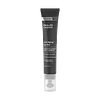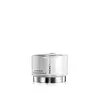What's inside
What's inside
 Key Ingredients
Key Ingredients

 Benefits
Benefits

 Concerns
Concerns

No concerns
 Ingredients Side-by-side
Ingredients Side-by-side

Water
Skin ConditioningCyclopentasiloxane
EmollientButylene Glycol
HumectantPentylene Glycol
Skin ConditioningTapioca Starch
Methyl Gluceth-20 Benzoate
EmollientGlycerin
HumectantDimethicone
EmollientCyclohexasiloxane
EmollientPolysilicone-11
Palmitoyl Tripeptide-38
Skin ConditioningCaprooyl Tetrapeptide-3
Skin ProtectingPalmitoyl Tripeptide-5
Skin ConditioningNiacinamide
SmoothingPhospholipids
Skin ConditioningHyaluronic Acid
HumectantSodium Hyaluronate
HumectantVitis Vinifera Seed Extract
AntimicrobialPanthenol
Skin ConditioningSalix Alba Extract
Skin ConditioningCamellia Sinensis Leaf Extract
AntimicrobialAdenosine
Skin ConditioningGlycyrrhiza Glabra Root Extract
BleachingPisum Sativum Extract
Skin ConditioningPolyacrylate Crosspolymer-6
Emulsion StabilisingDunaliella Salina Extract
Skin ConditioningHydroxypropyl Cyclodextrin
MaskingDextran
Polysorbate 20
EmulsifyingAmmonium Acryloyldimethyltaurate/Vp Copolymer
Disodium EDTA
Phenoxyethanol
PreservativeWater, Cyclopentasiloxane, Butylene Glycol, Pentylene Glycol, Tapioca Starch, Methyl Gluceth-20 Benzoate, Glycerin, Dimethicone, Cyclohexasiloxane, Polysilicone-11, Palmitoyl Tripeptide-38, Caprooyl Tetrapeptide-3, Palmitoyl Tripeptide-5, Niacinamide, Phospholipids, Hyaluronic Acid, Sodium Hyaluronate, Vitis Vinifera Seed Extract, Panthenol, Salix Alba Extract, Camellia Sinensis Leaf Extract, Adenosine, Glycyrrhiza Glabra Root Extract, Pisum Sativum Extract, Polyacrylate Crosspolymer-6, Dunaliella Salina Extract, Hydroxypropyl Cyclodextrin, Dextran, Polysorbate 20, Ammonium Acryloyldimethyltaurate/Vp Copolymer, Disodium EDTA, Phenoxyethanol
Phyllostachys Bambusoides Juice
Skin ConditioningCyclopentasiloxane
EmollientDimethicone
EmollientGlycerin
HumectantButylene Glycol
HumectantCyclohexasiloxane
EmollientAlcohol
AntimicrobialWater
Skin ConditioningPEG-75
HumectantPEG-10 Dimethicone
Skin ConditioningBiosaccharide Gum-1
HumectantSqualane
EmollientNiacinamide
SmoothingAcetyl Glucosamine
Skin ConditioningHydrolyzed Phyllostachys Bambusoides
HumectantHydrolyzed Camellia Sinensis Leaf
HumectantGlycine Soja Seed Extract
Skin ConditioningNelumbo Nucifera Flower Extract
Skin ConditioningOpuntia Coccinellifera Fruit Extract
Skin ConditioningHesperidin
EmollientCaffeine
Skin ConditioningTheanine
EmollientKaempferol
AntioxidantCamellia Sinensis Flower Extract
PerfumingNatto Gum
Beta-Glucan
Skin ConditioningSodium Hyaluronate
HumectantTocopherol
AntioxidantPhytantriol
HumectantEpigallocatechin Gallate
AntioxidantDisteardimonium Hectorite
StabilisingLauryl PEG-9 Polydimethylsiloxyethyl Dimethicone
Skin ConditioningPolysilicone-11
Propanediol
SolventDimethiconol
EmollientDimethicone/Vinyl Dimethicone Crosspolymer
Skin ConditioningStearyl Behenate
EmollientPolyglyceryl-3 Methylglucose Distearate
EmulsifyingHydroxypropyl Bispalmitamide Mea
EmollientInulin Lauryl Carbamate
Emulsion StabilisingPolysorbate 20
EmulsifyingPEG-15 Pentaerythrityl Tetra(Laureth-6 Carboxylate)
HumectantSodium Chloride
MaskingPoloxamer 407
EmulsifyingAmmonium Acryloyldimethyltaurate/Vp Copolymer
1,2-Hexanediol
Skin ConditioningDisodium EDTA
Ethylhexylglycerin
Skin ConditioningPhenoxyethanol
PreservativeParfum
MaskingPhyllostachys Bambusoides Juice, Cyclopentasiloxane, Dimethicone, Glycerin, Butylene Glycol, Cyclohexasiloxane, Alcohol, Water, PEG-75, PEG-10 Dimethicone, Biosaccharide Gum-1, Squalane, Niacinamide, Acetyl Glucosamine, Hydrolyzed Phyllostachys Bambusoides, Hydrolyzed Camellia Sinensis Leaf, Glycine Soja Seed Extract, Nelumbo Nucifera Flower Extract, Opuntia Coccinellifera Fruit Extract, Hesperidin, Caffeine, Theanine, Kaempferol, Camellia Sinensis Flower Extract, Natto Gum, Beta-Glucan, Sodium Hyaluronate, Tocopherol, Phytantriol, Epigallocatechin Gallate, Disteardimonium Hectorite, Lauryl PEG-9 Polydimethylsiloxyethyl Dimethicone, Polysilicone-11, Propanediol, Dimethiconol, Dimethicone/Vinyl Dimethicone Crosspolymer, Stearyl Behenate, Polyglyceryl-3 Methylglucose Distearate, Hydroxypropyl Bispalmitamide Mea, Inulin Lauryl Carbamate, Polysorbate 20, PEG-15 Pentaerythrityl Tetra(Laureth-6 Carboxylate), Sodium Chloride, Poloxamer 407, Ammonium Acryloyldimethyltaurate/Vp Copolymer, 1,2-Hexanediol, Disodium EDTA, Ethylhexylglycerin, Phenoxyethanol, Parfum
Ingredients Explained
These ingredients are found in both products.
Ingredients higher up in an ingredient list are typically present in a larger amount.
Ammonium Acryloyldimethyltaurate/Vp Copolymer (let's call it AAVC for short) is a synthetically created polymer. It's used as a film-forming agent and used to thicken the consistency of products.
AAVC is able to increase the consistency and viscosity of products due to its large molecule size. It also prevents ingredients from separating.
Butylene Glycol (or BG) is used within cosmetic products for a few different reasons:
Overall, Butylene Glycol is a safe and well-rounded ingredient that works well with other ingredients.
Though this ingredient works well with most skin types, some people with sensitive skin may experience a reaction such as allergic rashes, closed comedones, or itchiness.
Learn more about Butylene GlycolCyclohexasiloxane is a type of silicone more commonly known as D6. It is an emollient and solvent.
Cyclohexasiloxane is used to evenly distribute ingredients throughout the product. When applied to the skin, Cyclohexasiloxane evaporates and leaves behind a silky feel.
As an emollient, it can help the skin feel soft and hydrated. It is also used to reduce frizz in hair products.
Learn more about CyclohexasiloxaneCyclopentasiloxane, or D5, is a silicone used to improve texture of products and trap moisture.
D5 is considered lightweight and volatile. Volatile means it evaporates quickly after application. Once evaporated, D5 leaves a thin barrier that helps keep skin hydrated.
It is also an emollient. Emollients help soften the skin and prevent water loss. Silicones create a silky texture in products. D5 helps other ingredients become more spreadable.
Studies show D5 is safe to use in skincare products. We recommend speaking with a skincare professional if you have concerns.
Learn more about CyclopentasiloxaneDimethicone is a type of synthetic silicone created from natural materials such as quartz.
What it does:
Dimethicone comes in different viscosities:
Depending on the viscosity, dimethicone has different properties.
Ingredients lists don't always show which type is used, so we recommend reaching out to the brand if you have questions about the viscosity.
This ingredient is unlikely to cause irritation because it does not get absorbed into skin. However, people with silicone allergies should be careful about using this ingredient.
Note: Dimethicone may contribute to pilling. This is because it is not oil or water soluble, so pilling may occur when layered with products. When mixed with heavy oils in a formula, the outcome is also quite greasy.
Learn more about DimethiconeDisodium EDTA plays a role in making products more stable by aiding other preservatives.
It is a chelating agent, meaning it neutralizes metal ions that may be found in a product.
Disodium EDTA is a salt of edetic acid and is found to be safe in cosmetic ingredients.
Learn more about Disodium EDTAGlycerin is already naturally found in your skin. It helps moisturize and protect your skin.
A study from 2016 found glycerin to be more effective as a humectant than AHAs and hyaluronic acid.
As a humectant, it helps the skin stay hydrated by pulling moisture to your skin. The low molecular weight of glycerin allows it to pull moisture into the deeper layers of your skin.
Hydrated skin improves your skin barrier; Your skin barrier helps protect against irritants and bacteria.
Glycerin has also been found to have antimicrobial and antiviral properties. Due to these properties, glycerin is often used in wound and burn treatments.
In cosmetics, glycerin is usually derived from plants such as soybean or palm. However, it can also be sourced from animals, such as tallow or animal fat.
This ingredient is organic, colorless, odorless, and non-toxic.
Glycerin is the name for this ingredient in American English. British English uses Glycerol/Glycerine.
Learn more about GlycerinNiacinamide is a multitasking form of vitamin B3 that strengthens the skin barrier, reduces pores and dark spots, regulates oil, and improves signs of aging.
And the best part? It's gentle and well-tolerated by most skin types, including sensitive and reactive skin.
You might have heard of "niacin flush", or the reddening of skin that causes itchiness. Niacinamide has not been found to cause this.
In very rare cases, some individuals may not be able to tolerate niacinamide at all or experience an allergic reaction to it.
If you are experiencing flaking, irritation, and dryness with this ingredient, be sure to double check all your products as this ingredient can be found in all categories of skincare.
When incorporating niacinamide into your routine, look out for concentration amounts. Typically, 5% niacinamide provides benefits such as fading dark spots. However, if you have sensitive skin, it is better to begin with a smaller concentration.
When you apply niacinamide to your skin, your body converts it into nicotinamide adenine dinucleotide (NAD). NAD is an essential coenzyme that is already found in your cells as "fuel" and powers countless biological processes.
In your skin, NAD helps repair cell damage, produce new healthy cells, support collagen production, strengthen the skin barrier, and fight environmental stressors (like UV and pollution).
Our natural NAD levels start to decline with age, leading to slower skin repair, visible aging, and a weaker skin barrier. By providing your skin niacinamide, you're recharging your skin's NAD levels. This leads to stronger, healthier, and younger looking skin.
Another name for vitamin B3 is nicotinamide. This vitamin is water-soluble and our bodies don't store it. We obtain Vitamin B3 from either food or skincare. Meat, fish, wheat, yeast, and leafy greens contain vitamin B3.
The type of niacinamide used in skincare is synthetically created.
Learn more about NiacinamidePhenoxyethanol is a preservative that has germicide, antimicrobial, and aromatic properties. Studies show that phenoxyethanol can prevent microbial growth. By itself, it has a scent that is similar to that of a rose.
It's often used in formulations along with Caprylyl Glycol to preserve the shelf life of products.
Polysilicone-11 is a film-forming silicone that creates a non-tacky and matte finish on the skin. It's commonly used to improve texture, absorb excess oil, and help active ingredients spread evenly.
Due to its "rubber-like" structure, it stays on the skin's surface instead of being absorbed. On the skin, it creates a flexible layer that enhances wearability and stability.
Polysorbate 20 is made by combining ethoxylation of sorbitan, ethylene oxide, and lauric acid. It is a mild cleansing agent, surfactant, and emulsifier.
As a surfactant, it helps collect dirt and oils for washing. Emulsifiers prevent oils and water from separating.
Polysorbate 20 also adds scent to a product. Since it is made using sorbitol, it has a sweet scent. Sorbitol can also be found in fruits such as apples and peaches.
The lauric acid used to create Polysorbate 20 is often derived from coconuts.
Polysorbate 20 may not be fungal acne safe.
Learn more about Polysorbate 20Sodium Hyaluronate is hyaluronic acid's salt form. It is commonly derived from the sodium salt of hyaluronic acid.
Like hyaluronic acid, it is great at holding water and acts as a humectant. This makes it a great skin hydrating ingredient.
Sodium Hyaluronate is naturally occurring in our bodies and is mostly found in eye fluid and joints.
These are some other common types of Hyaluronic Acid:
Learn more about Sodium HyaluronateWater. It's the most common cosmetic ingredient of all. You'll usually see it at the top of ingredient lists, meaning that it makes up the largest part of the product.
So why is it so popular? Water most often acts as a solvent - this means that it helps dissolve other ingredients into the formulation.
You'll also recognize water as that liquid we all need to stay alive. If you see this, drink a glass of water. Stay hydrated!
Learn more about Water